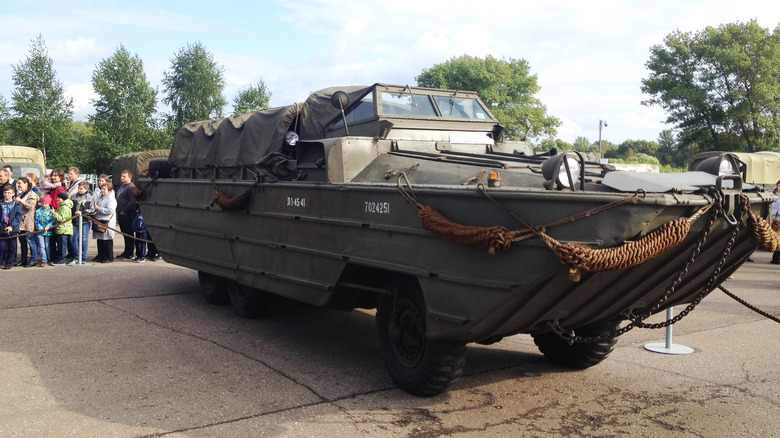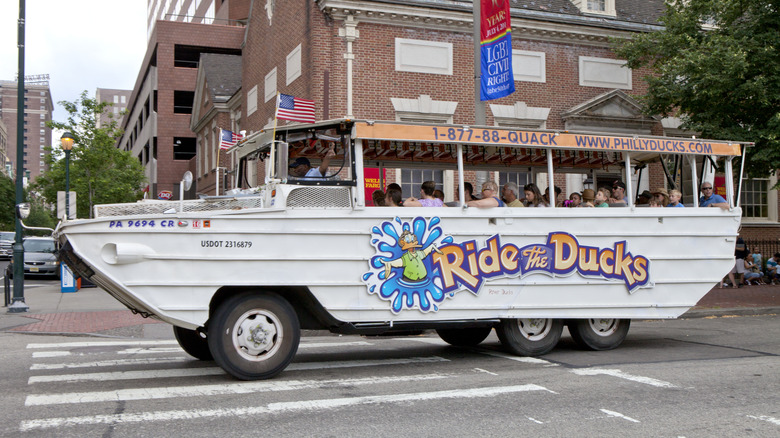The Story Behind The Odd Amphibian Military Vehicle-Turned Tourist Attraction
It's 1943, and the United States is in the midst of World War II. The Allied forces must wrest control of Italy from the Axis powers comprised of Germany, Italy and Japan. To do that, they must start with Sicily (the toe of the boot), the largest island in the Mediterranean Sea.
The U.S. Seventh Army and the British Eighth Army joined forces in Operation Husky to keep the Axis armies from moving their most formidable divisions off the island to continue the war on the mainland. Since Sicily is an island, the Allies needed a way to get ammunition, supplies, and equipment from their big, well-armored ships anchored out in open water to the enemy-held beaches and coastline without becoming sitting ducks for Axis artillery.
Until that time in naval history, nothing existed that could expedite the offloading of goods quickly. Large vessels either sidled up next to a dock to unload their wares or sailors used smaller dinghy boats to move things back and forth from ship to shore. Neither of those suited the quick hit-and-run tactics needed for a beach assault.
Enter the DUKW, created by General Motors, which made its first combat appearance during Operation Husky. The DUKW was actually based on GMC's famous 6x6 wheeled CCKW truck introduced in 1941, more affectionately referred to as the "deuce-and-a-half."
If it looks like a duck and walks like a duck...
GMC stuck a boat hull with a propeller on top of a CCKW chassis equipped with a 6-cylinder, 269 cubic inches with 91.5 horsepower. The amphibious beast was 31 feet long, 8.25 feet wide, and 8.8 feet high. It could scoot down the road at 50 to 55 mph, power through water at 6.4 mph, and carry 2.5 tons of cargo (via The World War II Database).
The "DUKW" terminology was based on GM's manufacturing code. The "D" designated it as a "1942 model," the "U" was for "utility," the "K" for "all-wheel drive" and the "W" was for "dual rear wheels." After seeing it in operation, soldiers just started calling them "ducks" ... for obvious reasons.
Because of the need to work on roads, beaches, and in the water, the Duck became the first vehicle where the driver could change the tire pressure from inside to quickly and easily accommodate changing conditions. The DUKW wasn't armor-plated, though, as that would have made it too heavy. Instead, the hull was covered with sheet steel between 1/16" and 1/8" thick. As long as artillery rounds were less than two inches in width, the high capacity bilge pump could keep it floating above water and operational. A total of 21,137 were built (via The World War II Database).
After its success in Operation Husky, the DUKW was used numerous times in the Mediterranean, Pacific and specifically during the June 1944 invasion of Normandy on D-Day. It's also where the DUKW found its weakness. Used to get supplies onto Omaha Beach, Ducks were overloaded with soldiers, ammo, and medicine. Twelve of the amphibious craft were tasked with carrying heavy Howitzer cannons, which in and of themselves weighed 2.5 tons.
One if by land, two if by sea
This wouldn't have been a problem in calm waters, but the waves crashing on Omaha Beach that fateful day were anything but tranquil. Three to five-foot surges battered the Ducks as they left ships, and all but one of those carrying the Howitzers sank quickly.
"What happened on Omaha Beach in particular was that we tried to do too much with Ducks," said Joseph Balkoski, author of several military history books and official historian of the Maryland National Guard (via History). "That normally would not have been an issue in calm waters. A duck is designed to carry a heavy load."
When World War II was over, the DUKWs were used in myriad ways by many different militaries worldwide. The Australian Army used them during an Antarctic research expedition in 1948. The U.S. military used them again during the Korean War; the French during the First Indochina War; and the British during the Indonesia-Malaysia confrontation in 1962. They were even used in the aftermath of Hurricane Katrina (via The World War II Database).
Eventually, at least in the U.S., they became known as a way for companies to provide unique guided tours in a vehicle that could drive through towns and plunge straight into the water without changing vehicles. They were all the rage until 2018, when 17 people died at Table Rock Lake in the Ozarks near Branson, Missouri, when powerful waves capsized a Duck boat. While you can still find these tours around the country, the Duck's appeal appears to be waning.

